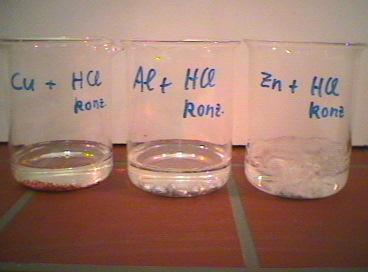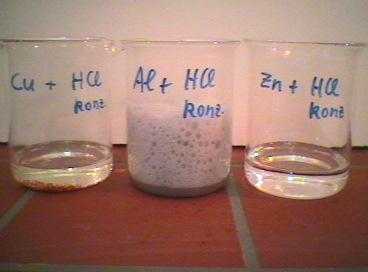



| 1. |  |
2. |  |
| Experimental setup: copper, aluminum, zinc | Addition of concentrated hydrochloric acid; zinc reacts immediately | ||
| 3. |  |
4. |  |
| The aluminum reaction begins | Aluminum has reacted violently; copper has not reacted; zinc has dissolved |
| Photo 1: | Experimental setup: Concentrated hydrochloric acid is simultaneously added to the following metals: copper, aluminum and zinc. |
| Photo 2: | Immediately following the addition, no reaction takes place in the cases of copper and aluminum. Zinc, on the other hand,
reacts immediately by vigorously producing hydrogen according to:
Zn + 2 HCl > ZnCl2 + H2 |
| Photo 3: | After approx. one minute, the zinc has almost completely reacted. Copper continues to show no reaction. As for the aluminium, we see the beginnings of a reaction taking place, namely the production of hydrogen.
This time delay can be traced back to the passive corrosion of the aluminum due to an impermeable protective layer composed of aluminum hydroxide/oxide, which must first be dissolved by the hydrochloric acid:
Al(OH)3 + 3 H3O+ > Al3+ + 6 H2O
or Al2O3 + 6 H3O+ > 2 Al3+ + 6 H2O
Al + 3 H3O+ > Al3+ + 3 H2O + 3/2 H2 |
| Photo 4: | Aluminum reacts analagously to zinc: quite lively with concentrated hydrochloric acid. Copper, on the other hand, is completely unreactive. This can be explained by looking at its position in the electrochemical series of metals. Copper belongs to the noble metals. These stand in the row after hydrogen and are not affected by non-oxidizing acids (see Chapter 11), which is why they are not dissolved by hydrochloric acid. |